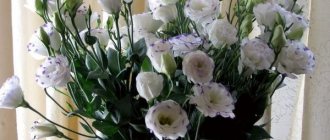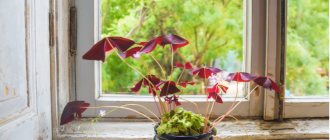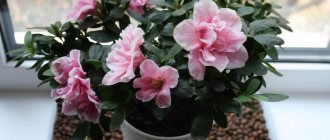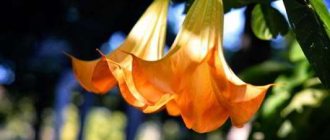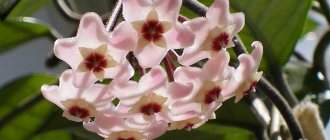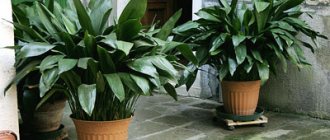Botanical description and characteristics
Dieffenbachia is a genus of perennial plants from the Aroid family that includes more than 60 species. Originates from the tropics of Central and South America, in culture for more than 150 years.
Suitable for landscaping residential or public spaces.
Appearance
A mature Dieffenbachia is a herbaceous evergreen plant with thick, erect shoots that look like the central conductor of a tree. Usually it does not branch, gradually loses its lower plates, leaving scars on the stem, and becomes like a palm tree with a crooked trunk and a rosette of leaves at the top.
Dieffenbachia reaches 3 meters in nature. At home it grows up to 1.5-2 m. The stem only seems strong, but in fact it can break or crack due to:
- careless handling;
- pot falling;
- strong wind;
- concussions;
- under its own weight.
Dieffenbachia grows quickly. Many species and varieties stretch up to 2 m in 5 years without pruning.
Dieffenbachia is grown for its beautiful, large, leathery leaves. Under natural conditions, in different species they can have a length of 30-75 cm with a width of 15-40 cm. Cultivated varieties of Dieffenbachia usually do not reach this size.
The flower will not immediately grow large leaves. In a very young specimen, they will initially be the size of a palm, but they are constantly increasing. Only mature plants can boast of real “burdocks” that correspond to the varietal description.
Dieffenbachia leaves are usually oval, rarely ovate, with a sharp tip, solid, smooth or wavy edge. The venation is clear. The variegated coloring makes it especially decorative; only in certain species it can be plain-colored.
Dieffenbachia plates are painted with light green, white, yellow, olive, and all shades of green patterns. It can consist of strokes, spots, stripes, fill the inside, or run along the veins.
During the period of active development, with good maintenance, an adult plant produces one new leaf per week.
Bloom
Dieffenbachia blooms in cultivation extremely rarely. The thin, even white or cream-colored cob and greenish sail are not of particular decorative value, but they take a lot of energy from the plant. The smell is sweetish, not very pleasant.
If the owners do not intend to get their own seeds, which is only possible with hand pollination, it is recommended to remove the flower stalks as soon as they appear. The fruits are red or orange berries and look quite attractive.
At home, Dieffenbachia can be caused to bloom by stress - light, cool conditions without fertilizing and drought until the leaves droop. But the more than modest result does not justify such execution.
general information
Dieffenbachia owes its difficult name to the German botanist Dieffenbach. In nature, it grows in South America, like many other similar species. Outwardly, it resembles not a shrub, but a small tree with a full-fledged trunk, from which large leaves spread out densely.
Dieffenbachia has one interesting growth feature - it grows only from above. Therefore, gradually the lower leaves will die off, and the stem will become more and more like a bare trunk. In this form, the flower can stretch even several meters. But this happens infrequently, because for all its visual impressiveness it is very fragile.
Photo: lesnaya-aptechka.ru
In fact, Dieffenbachia is a flowering plant, but this happens extremely rarely at home. To do this, you really have to work hard to recreate suitable conditions. In this case, the flowers bloom every year, and thanks to artificial pollination they can even bear fruit.
Please note that the leaves and stems of Dieffenbachia have quite poisonous juice. It won’t harm you in any way at home, but if it gets on your mucous membrane, it can cause a serious burn. Therefore, it is better not to keep the flowerpot where small children or pets can reach it.
Photo: happymodern.ru
Is it possible to keep the plant at home?
When placing, you need to take into account that Dieffenbachia juice is poisonous. It should not get into wounds or mucous membranes, since all parts contain calcium oxalate and can cause allergies or irritation.
The same can be said about other Aroids. But for some reason, beautifully flowering spathiphyllums or anthuriums are considered almost harmless, and people are afraid to keep dieffenbachias, monsteras and philodendrons in the house.
To get seriously poisoned, you need to eat a lot of leaves or a large piece of shoot. But the culture effectively cleanses the air of formaldehyde.
Humidity
Watering should be plentiful in the warm season, but the soil should not look like liquid mud. With the arrival of winter, moisture should be reduced, but the soil in the pot should not dry out even at this time.
To grow such a crop, you don’t have to spend a lot of effort on care. A photo of Dieffenbachia can give the impression that the plant is beautiful, and therefore capricious. This is wrong. Dieffenbachia is an unpretentious crop. As for air humidity, it should be high, about 65%. That is why washing the leaf plates and spraying are a must. The more often you carry out this procedure, the much better the plant will feel. For wiping and watering, use only boiled or settled water at room temperature. Sometimes a plant needs a warm shower if it is small in size. Water should not get on the ground.
How to choose Dieffenbachia in a store
First of all, future owners must decide on the variety. Of course, the pattern, size and color of the leaves are of great importance, but you need to take into account:
- how fast does the variety of Dieffenbachia you like grow, will there be enough space for it in the apartment;
- Is it possible to provide a flower with almost white leaves with good lighting;
- Will a plant with large half-meter plates fit on a windowsill in a small room?
Young specimens usually go on sale. What the indoor Dieffenbachia flower will be like when it grows, you need to ask the seller, or choose a variety in advance and study the description.
Then you need to inspect the above-ground part. Bad signs:
- withered leaves;
- dry ends;
- damage or yellowing of vegetative organs;
- any raid;
- bare trunk;
- traces of pests or diseases.
A small number of plates on the top of the head indicate that they flew around or were torn off intentionally. Nobody will do this just like that; it’s better to refuse the purchase.
If the Dieffenbachia is healthy, sellers usually do not mind the flower being removed from the pot. You should not take plants from which:
- the roots have grown to the walls of the container;
- the ground smells bad;
- the soil is covered with a whitish coating;
- the sucking shoots rot;
- the lump falls apart, is poorly braided;
- many dry, black or dark brown roots.
At home, Dieffenbachia is placed for 2 weeks in a slightly shaded place separately from other indoor flowers. During adaptation, they look for signs of diseases or pests. Then, if necessary, they replant from a cramped pot and replace the transport peat with a regular substrate.
Camilla
Another popular variety of Dieffenbachia, which came to us from the tropical forests of South America. This species grows up to two meters in length. On a strong stem there are large, oblong leaves, which are white closer to the middle, with a green border along the edge. With age, white spots disappear from the leaves of Dieffenbachia macrophylla. Camilla develops quickly - a new leaf grows within a week. In a ventilated room, protected from drafts, a shaded corner will be the best place for this plant.
How to transplant Dieffenbachia
The operation is performed every 2-3 years, preferably in spring or early summer. At this time, the growth of all vegetative organs, including roots, is activated. The plant quickly recovers and produces new leaves.
Suitable soil
The culture does not make high demands on the substrate. The main thing is that it should be:
- permeable to air and water;
- slightly acidic;
- moisture-intensive;
- with a stable structure - not prone to bunching up or “floating”.
Soil for Dieffenbachia can be taken ready-made. Suitable for decorative foliage plants, palm trees. Experienced flower growers improve it by adding about 20%:
- vermiculite;
- coconut fiber;
- sphagnum;
- brick chips;
- pieces of charcoal.
The soil for Dieffenbachia can be prepared independently:
- coniferous land - 1 part;
- garden soil - 1;
- chopped sphagnum - 1;
- coarse sand or vermiculite – 0.5.
Drainage
This is worth writing about separately. There must be a layer between the substrate and the bottom of the pot - the crop loves moist soil, but cannot tolerate stagnant water or soaking roots.
Most gardeners are accustomed to placing expanded clay or pieces of foam at the bottom of the container. But Dieffenbachia grows large at home, often in one trunk. If the flower is tall, the lower part will become bare over time, and the main weight will be concentrated at the top - it will be made up of a mass of long, wide leaves.
Any careless movement or under its own weight may cause the plant to overturn. To avoid troubles, you should place, for example, a stone at the bottom.
Choosing a pot
A pot for Dieffenbachia can be taken in a regular shape, with a diameter 2-3 cm larger than the root ball. The best material is plastic, it allows water and air to pass through well, but you can choose heavier ones, made of clay or ceramics. The main thing is that there are drainage holes.
If the design of the pot does not fit into the interior, it can be placed in a beautiful flowerpot or decorated outside.
Transplantation process
The operation is not at all difficult, but for large plants it is better to do it together. One person holds the flower by the trunk, the other plants it. It is recommended to wear gloves.
Dieffenbachia transplant:
- A new pot is being prepared. Place drainage and a layer of fresh soil at the bottom.
- The plant is removed from the old container. The horses are examined, if necessary, cleaned to healthy tissue, and the wounds are sprinkled with crushed coal.
- Place the Dieffenbachia in the center of the pot so as to deepen the trunk a few centimeters.
- Fill the free space with fresh soil. Slightly crushed on the sides.
- Water the first time - preferably in a tray. Excess water is removed after 20-30 minutes.
- Place in a slightly shaded but not dark place. They send it permanently when a new leaf appears.
Transfer rules
As the crop grows, it needs to renew the land. Dieffenbachia must also be replanted as the root system fills the space in the pot. In some cases, this procedure is carried out twice a year, and it is best to do this between February and May.
The pot is selected to be a couple of centimeters larger in diameter than the old one. A decent drainage layer of pebbles, expanded clay or broken brick is placed in it. Then the earthen ball, together with the root system of the plant, is transferred into a new container. There is no need to clean the soil from adhering elements of old drainage. After this, the required amount of slightly acidic fresh loose substrate is added, which consists of 1 part peat, 2 parts leaf soil, as well as 1 part fine sphagnum and half part coarse river sand.
How to care for Dieffenbachia
Caring for a flower is not difficult, it does not take much time. The main thing is to choose the right place and water regularly.
Lighting and temperature
The plant is very heat-loving, but does not withstand heat well. The temperature minimum is 17° C even during a mild rest period. In summer, the thermometer should fluctuate between 20-23°C; after 25°C, life processes stop.
Variegated Dieffenbachias need diffused sun without direct rays. The more white or light green areas there are on the plates, the more intense the lighting should be, otherwise the variegated color will fade.
Species and varieties with smoothly colored leaves can be kept in partial shade. If you put Dieffenbachia Camilla there, most of the plate of which is occupied by a central light spot, it will lose its decorative effect.
The stem of a plant without sun becomes very elongated, remaining thin, and the leaves at the base turn yellow prematurely.
Watering and air humidity
Dieffenbachia should be watered intensively, in the summer - once every few days. During the activation of growth processes, and especially when it is hot, the ground should always remain moist - huge leaves evaporate a lot of water.
During cool winters, less frequent watering is needed. But if the pot with the plant is located next to heating devices, the top layer of the substrate should only dry out a little.
All types of Dieffenbachia do not tolerate stagnation of water in the pot, despite the high need for watering. This causes root rot. The liquid from the pan must be removed after 20-30 minutes; if the container is too heavy, you can collect it with a syringe.
You cannot use hard or chlorinated water, you need to stand for at least 12 hours and drain the sediment.
High humidity is needed, otherwise the edges and tips of the leaves turn yellow and then become dry. They need to be sprayed frequently, preferably several times a day, with clean water. Only if the temperature approaches the permissible minimum, the overhead irrigation is reduced, and dust is removed from the plates with a damp cloth.
Top dressing
Even experts have differing opinions here. Some in spring and summer advise watering Dieffenbachia with a solution of fertilizers containing high doses of nitrogen every 7 days, others - twice a month.
Obviously, tall, fast-growing, well-leafed plants need more nutrition than compact varieties. From October to the end of February, feeding is stopped.
Dieffenbachia responds well to fertilizers for decorative leafy crops.
Pruning and rejuvenation
If the plant is allowed to develop freely, it will quickly reach 1.5 m or more, the trunk will bend, and eventually become bare at the bottom. Such a Dieffenbachia will definitely not be beautiful.
Pruning can solve the problem. To maintain decorativeness in tall species and varieties, it is done every 3 years. But you need to focus on appearance, not age - for some reason, Dieffenbachia sometimes slows down growth.
Compact varieties need rejuvenation from time to time. The operation is best done in spring or early summer.
On the trunk of the plant there are dormant buds, the growth of which is activated by pruning. If you make it high, one replacement vertical shoot will appear. If it is short, several stems will hatch and you will get Dieffenbachia bush. They will grow upward, eventually become bare and turn into a group of trunks with rosettes of leaves on the tops.
When rejuvenating pruning, a column 10-15 cm high is left in Dieffenbachia. The top is separated at a right angle, used for propagation, and the wound is sprinkled with crushed activated carbon.
Rejuvenation
A bare long trunk makes it uncomfortable to care for a plant that requires additional support. In addition, the decorative effect suffers greatly, because instead of a lush bush, a bare stem stretches upward.
There are two ways to return Dieffenbachia to its aesthetic appearance:
- By pinching the growing point on the crown, this will probably awaken the dormant buds on the trunk and force the flower to produce new shoots.
- Trimming the crown and its subsequent rooting. To do this, the top is cut off approximately at a distance of a couple of centimeters from the node in which the dormant buds are located. The oozing stem is blotted dry and sprinkled with activated carbon. Then it can be planted in a new pot with loose, non-moisture-absorbing soil. It is important not to overwater a new plant to prevent the root and trunk from rotting before the roots grow. The remaining nodes of the long stem can be divided into cuttings and planted. New Dieffenbachia will grow from them, indistinguishable from the mother one.
Reproduction methods
It is theoretically possible to grow Dieffenbachia from seeds, but only breeders do this. Moreover, interspecific crossing in the crop occurs easily, and seedlings do not inherit varietal characteristics.
Vegetative propagation of Dieffenbachia by cuttings taken from the top or middle of the trunk is suitable for amateurs. Pieces of stems remaining after rejuvenation are suitable:
- If Dieffenbachia is going to be kept in water, the cuttings are cut with 3-4 nodes, 10-20 cm long. To immediately plant them in peat with vermiculite or sand, they are made 5-7 cm long, leaving 1-2 buds.
- The cuttings are dried for 1-2 days, the wound surfaces are treated with crushed coal, the lower cut can be lowered into a root formation stimulator.
- Place in water or plant so that the lower internode is in the substrate or liquid.
- If the room has high humidity, you don’t have to cover the cuttings with a bag or glass.
- Keep at a temperature of 20-25 ° C, ventilate daily, water the substrate if necessary.
- When the roots of Dieffenbachia in water reach a length of 3 cm, they are planted in light soil.
The culture propagates easily, but it can take six months from cuttings to the appearance of new leaves and complete rooting.
Trimming
In some cases, Dieffenbachia needs to remove damaged leaves. If the plant grows too quickly, then it is also necessary to take some pruning measures.
In such situations, first of all it is necessary to blot the damaged leaf plate with a napkin. This will prevent plant sap from coming into contact with your skin during pruning. After this, a clean blade or knife, which is treated with an alcohol solution for disinfection, is used to cut off a leaf plate or a small part of the trunk. The damaged areas must be blotted again with a napkin, which will absorb the juice, then treated with crushed charcoal. Pruning is carried out only with gloves, and the remaining parts of the plant can be used for future propagation.
Problems when growing a flower
Dieffenbachia is a strong plant. But careless owners who believe that if a flower is easy to maintain, then it is not necessary to care for it, will constantly encounter problems. They do not kill the plant, but they significantly reduce the decorative effect.
Diseases
Root rot occurs from overwatering and spoiled, acidifying soil. If, when preparing the substrate on their own, the owners doubt whether they will be able to properly disinfect all the components, it is recommended to use a purchased one. It can be improved with vermiculite or sphagnum.
The following pathogens can get into a pot with Dieffenbachia along with garden or garden soil:
- leaf spotting;
- anthracnose;
- fusarium.
Fungicides will deal with them. But if the crop becomes sick with bacteriosis, mosaic or bronzing, the plant will have to be thrown away.
Pests
Dieffenbachia can grow on:
- spider mites;
- thrips;
- scale insects;
- aphids;
- Mealybugs.
The plant will have to be treated with an insecticide several times. For indoor flowers, Actellik is usually used.
Other problems
In addition to infectious diseases and pests, maintenance errors will lead to negative consequences:
- leaves fall off en masse due to cold or low humidity;
- only the lower ones - a physiological process, nothing needs to be done;
- the plates turn yellow, curl up - draft, too low temperature;
- the base of the trunk rots - cold plus soaking of the roots;
- brown tips of leaves - watering with hard water;
- dry – low air humidity;
- yellowing of the plates without deformation - excessive irrigation.
Errors in care and their signs in the plant
Healthy Dieffenbachia delights owners with juicy, bright, large greens. If the cultivation rules are not followed, the plant communicates the problem with a corresponding appearance.
| Changes | Possible reasons |
| The ends dry out and crumble |
|
| Fading leaves, loss of contrast |
|
| Small misshapen leaves | Soil is too alkaline |
| The lower leaves dry out and fall off | cramped potty |
| Pale and softened stem | Root Rotting |
| The leaves are curling |
|
| Brown edges |
|
| Yellow leaves |
|
Types and varieties of Dieffenbachia: photos with names
In indoor floriculture, Dieffenbachia Spotted, Seguin, Bauman, and Bauze are most often grown. The culture easily crosses between species and has many varieties and hybrids. The variegated ones are most valued; tall cultivars are used as interior flowers; compact ones are suitable for standard apartments.
Dieffenbachia mix is not a variety, but several, often belonging to different types of young plants, sold in a common tray.
Spotted
Dieffenbachia maculata reaches a meter in cultivation, but there is a variety with a height of 50-65 cm - Dieffenbachia Compacta. The stem is thick, the leaves are elongated oval or almost lanceolate, with sharp tips, up to 50 cm in size and about 13 cm wide.
Feature of the appearance: the center of the plate is decorated with light, usually white specks, strokes, stripes, spots of various configurations. The veins are pronounced, the length of the petioles is the same as that of the leaves or slightly shorter. The fruits are red-orange.
Varieties stand out:
- Dieffenbachia Tropic Snow - up to 0.8 m, with a stable trunk, dark green leaves covered with elongated white streaks and spots;
- Camilla - grows up to 2 m, the shoot bends strongly, lettuce plates with emerald edging and a stripe in the middle;
- Rudolf Roers - pistachio leaves, with a dark green border and central vein;
- resembles Aglaonema Dieffenbachia Vesuvius with narrow, long, light plates, decorated with small spots and a thin dark edging;
- Mars - with a marble pattern;
- Tropic Marianna is the lightest variety, only along the edge of the leaves there is a dark border;
- in Dieffenbachia Reflector, the color is similar to camouflage - dotted with light green or yellow spots, the central vein is white.
Lovely
Dieffenbachia amoena grows up to 2 m, the leaves are dense, oval, pointed at the end, about 50 cm long, 15 cm wide.
On a dark green background, light stripes and spots are grouped along the central and lateral veins. Dieffenbachia Charming grows up to 1.5 m.
Leopold
Dieffenbachia leipoldii Bull is distinguished by a short trunk, elongated oval, very dark green leaves with small petioles.
Only the central vein of the Dieffenbachia Leopolda species is decorated with a thick white stripe.
Magnificent (royal)
Dieffenbachia magnifica has oval leaves widening towards the base with a relatively short petiole.
The white pattern radiates from the green central vein.
large-leaved
Dieffenbachia Macrophylla is a plant with a powerful trunk up to 1 m high. The leaves are uniform, ovoid, grassy in color, soft compared to other species. They reach a length of 60 cm, a width of up to 40 cm. The central vein is thick.
Dieffenbachia macrophylla can withstand partial shade better than other representatives of the culture.
Bauze
Dieffenbachia bausei is one of the most beautiful species, up to 1.8 m high. The leaves are up to 35 cm long, oval, yellowish-green, marbled in color, with dark and almost white speckles.
Bauman
Dieffenbachia bowmannii has the largest (up to 70-80 cm) leaves of the cultivated species.
Small light spots are scattered on a dark green background.
Oersted
Dieffenbachia oerstedii is distinguished by its monochromatic, elongated, heart-shaped leaves with a sharp tip and up to 35 cm in length.
The central vein is white, sometimes there may be small spots of the same color on the plates.
Seguina
Dieffenbachia seguine is a common species similar to D. maculata. Dieffenbachia Seguina has a thick trunk, leaves 40-50 cm long, no more than 16 cm wide, short petiole, small light pattern.
Lovely
The leaves of Dieffenbachia charming, compared to many other species, are elongated in length and have a less pronounced rounded shape. The light pattern along the lateral veins on the leaf plate resembles a herringbone. The contrast of the background and dark green edges makes the plant very attractive. Good lighting makes the pattern even brighter and more noticeable. If elongated spots, white stripes, and strokes occupy most of the sheet, this species is called “Tropical Snow.”
